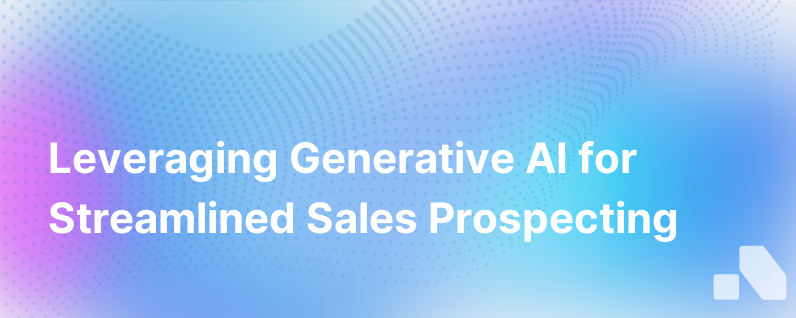
In recent years, the sales landscape has been revolutionized by the advent of Artificial Intelligence (AI), particularly the generative kind. Generative AI refers to algorithms that can generate text, images, or other data types that are completely new, rather than simply analyzing or categorizing existing data. As a consequence, the potential of such technology in the realm of sales prospecting is immense and transformative. Automated prospecting with generative AI isn't just about efficiency; it's an evolution in how businesses connect with potential clients, offering scalability, personalization, and strategic insights that were previously inconceivable.
The Revolution in Prospecting
Traditionally, sales prospecting has been a deeply manual and time-consuming process, with sales teams spending hours scouring through databases, social media, and other sources to find potential leads. Even with the advent of various digital tools, the grunt work of collating databases and sending out initial communications has remained labor-intensive and has often led to less time for closing actual sales.
Generative AI introduces a groundbreaking turnaround in this scenario. It allows the automation and personalization of outbound sales messaging at scale while bringing in a level of precision and efficiency that was not possible before. The following sections detail how generative AI propels the prospecting process into a new era.
Personalization at Scale
One of the most compelling benefits of using generative AI in prospecting is the ability to automate and personalize communication on a large scale. AI algorithms can analyze extensive datasets, understand patterns, and generate tailored messages that resonate with each individual prospect. This goes beyond including a prospect's name and company in an email—it understands their business needs, pain points, and can craft messages that speak directly to their situation.
Qualifying Leads with Precision
Generative AI can learn from past interactions and outcomes to refine how it qualifies leads. It can pore over substantial amounts of data to identify promising prospects based on firmographic and demographic data, as well as predictive indicators such as engagement levels, purchasing power, and needs alignment. By leveraging generative AI, sales teams can focus their energy on leads with the highest conversion potential.
Real-Time Insights and Adjustment
The agile nature of generative AI means that it can react to real-time feedback from interactions with prospects. It can adjust outreach tactics almost instantaneously, optimizing language and pitch angles based on what is resonating with prospects. This dynamic adjustment is a game-changer, turning each outreach into a learning opportunity to refine the approach.
Streamlining Sales Funnels
By automating the top of the sales funnel, generative AI frees sales representatives from the grind of lead generation and initial contact. Sales teams can dedicate more time to developing relationships and closing deals with qualified leads. This not only boosts productivity but also enhances job satisfaction as reps engage in higher-value, more rewarding work.
Challenges and Best Practices
Despite the vast potential of generative AI in automated prospecting, there are challenges and best practices that need consideration. For instance:
-
Data Quality Requirement: Generative AI is highly dependent on quality data. The age-old adage of "garbage in, garbage out" is especially pertinent here—AI can only generate quality outputs if it has access to high-quality inputs.
-
Ethical and Privacy Considerations: As with any AI deployment, particularly in sales, there are ethical implications. Prospects must be aware that they are interacting with AI during early touchpoints, and their data must be handled securely and respectfully.
-
Human Oversight: To ensure messaging remains on-brand and contextually appropriate, human oversight of AI-generated content is crucial. While AI is incredibly sophisticated, it's not immune to errors or tone-deaf communications.
-
AI Training and Fine-tuning: Successful implementation of generative AI requires continuous training to understand the nuances of different markets and refine its ability to communicate effectively.
Implementing Generative AI for Prospecting
For startups and established businesses alike, integrating generative AI into the sales process can seem daunting. Here’s a streamlined approach to incorporating generative AI into prospecting:
-
Define Goals and Metrics: Understand the specific outcomes you want from AI-enabled prospecting—be it increased lead volume, improved qualification, or higher conversion rates.
-
Select the Right Tools: Evaluate and choose AI tools that align with your objectives. Ensure they integrate with your existing Customer Relationship Management (CRM) and sales software.
-
Prepare Your Data: Organize and clean your existing databases and ensure ongoing data collection adheres to high-quality standards.
-
Train Your AI: Customize the AI's learning process by feeding it industry-specific information, sales playbooks, and communication guidelines.
-
Monitor and Optimize: Continuously measure outcomes against your predefined metrics, and tweak your AI's algorithms based on performance data.
-
Combine with Human Touch: Use Generative AI to facilitate the initial connection, but transition to human interaction as relationships build and opportunities progress.
-
Stay Compliant: Always comply with regulations such as GDPR, ensuring the AI system adheres to data privacy standards.
Final Thoughts
For businesses looking to supercharge their prospecting process, generative AI has unlocked new vistas of possibility. From crafting hyper-personalized outreach to dynamically adjusting to prospect feedback, AI-driven automated prospecting is reshaping how organizations identify, engage, and nurture potential customers.
At Aomni, we have seen firsthand the transformative power of generative AI in prospecting. By leveraging real-time account research, competitive insights, and personalized sales content, sales teams can connect with their ideal prospects more effectively than ever—with "zero effort" required. The future of sales prospecting is not just automated; it's intelligent, nuanced, and ever-evolving, thanks to the prowess of generative AI.